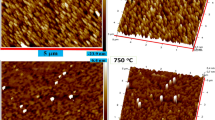Abstract
The cathodoluminescence and optical-transmission spectra of ZnS were analyzed to study the effect of a high hydrostatic gas pressure (1500 atm at 1000°C) on the equilibrium between intrinsic point defects in zinc sulfide grown by chemical vapor deposition (CVD) with an excess of zinc. The cathodoluminescence spectra were measured at 80–300 K and excitation levels of 1022 and 1026 cm−3 s−1; the optical-transmission spectra were measured at 300 K in the wavelength range 4–12 µm. It is found that exposure to a high hydrostatic gas pressure transforms the self-activated emission in the cathodoluminescence spectrum: (i) a new short-wave-length band appears at 415 nm with its intensity increasing by one to three orders of magnitude; and (ii) the long-wavelength band that peaks at 445 nm and is observed in as-grown crystals becomes quenched. Simultaneously, the cathodoluminescence band peaked at 850 nm and related to vacancies V S is no longer observed after high-pressure treatment. These effects are attributed to a partial escape of excess zinc (Zni) from crystals and additional incorporation of oxygen into lattice sites (OS). A doublet band I 1, which peaked at ∼331–332 nm at 80 K and at ∼342–343 nm at 300 K and is related to excitons bound to acceptor levels of oxygen centers, was observed. This band is found to be dominant in the cathodoluminescence spectrum at an excitation level of 1026 cm−3 s−1. Traces of the ZnO phase are apparent after the high-pressure treatment in both the cathodolumi-nescence spectra (the bands at 730 and 370 nm) and the transmission spectra (narrow bands in the region of 6–7 µm).
Similar content being viewed by others
References
N. K. Morozova, I. A. Karetnikov, V. V. Blinov, and E. M. Gavrishchuk, Fiz. Tekh. Poluprovodn. (St. Petersburg) 35, 25 (2001) [Semiconductors 35, 24 (2001)].
Yu. N. Dmitriev, V. D. Ryzhikov, and L. P. Gal’chinetskii, Thermodynamics of Isovalent Doping of Crystals of the II-VI Semiconductor Compounds (VNII Monokristallov, Khar’kov, 1990), No. IMK-90-16.
É. D. Aluker, D. Yu. Lusis, and S. A. Chernov, Electron Excitations and Radioluminescence in Alkali Metals (Zinatne, Riga, 1979).
N. K. Morozova, D. V. Zhukov, V. E. Mashchenko, and V. V. Blinov, in Proceedings of XXXII International Scientific and Technical Seminar on Noise and Degradation Processes in Semiconductor Devices (Mosk. Énerg. Inst., Moscow, 2002), p. 234.
N. K. Morozova and V. A. Kuznetsov, Zinc Sulfide. Production and Optical Properties, Ed. by M. V. Fok (Nauka, Moscow, 1987).
E. M. Gavrishchuk and É. V. Yashina, Vysokochist. Veshchestva, No. 5, 36 (1994).
C. M. J. Rooymans, Structural Investigations on Some Oxide and Other Chalcogenides at Normal and Very High Pressures (Philips, Eindhoven, 1968; Mir, Moscow, 1969).
V. M. Lisitsyn, V. I. Korepanov, V. I. Oleshko, and V. Yu. Yakovlev, Izv. Vyssh. Uchebn. Zaved., Fiz., No. 11, 5 (1996).
N. P. Golubeva and M. V. Fok, Zh. Prikl. Spektrosk. 17, 261 (1972).
K. Leutwein, A. Rauber, and J. Schneider, Solid State Commun. 5, 783 (1967).
N. K. Morozova, I. A. Karetnikov, E. M. Gavrishchuk, et al., in Proceedings of XXXIII International Scientific and Technical Seminar on Noise and Degradation Processes in Semiconductor Devices (Mosk. Énerg. Inst., Moscow, 2003), p. 12.
Nam Sungun, Rhee Jongkwang, O. Byungsung, and Ki-Seon Lee, J. Korean Phys. Soc. 32(2), 156 (1998).
N. Lovergine, P. Prete, G. Leo, et al., Cryst. Res. Technol. 33, 183 (1998).
Physics and Chemistry of II-VI Compounds, Ed. by M. Aven and J. S. Prener (North-Holland, Amsterdam, 1967; Mir, Moscow, 1970).
K. Akimoto, T. Miyajima, and Y. Mori, Phys. Rev. B 39, 3138 (1989).
A. M. Akhekyan, V. I. Kozlovskii, Yu. V. Korostelin, and Ya. K. Skasyrskii, Kratk. Soobshch. Fiz., No. 3, 44 (1988).
I. P. Kuz’mina and V. A. Nikitenko, Zinc Oxide (Nauka, Moscow, 1984), p. 165.
N. K. Morozova, V. G. Plotnichenko, E. M. Gavrishchuk, and V. V. Blinov, Neorg. Mater. 39, 1105 (2003).
R. J. Collins and D. A. Kleiman, J. Phys. Chem. Solids 11, 190 (1959).
Author information
Authors and Affiliations
Additional information
__________
Translated from Fizika i Tekhnika Poluprovodnikov, Vol. 38, No. 1, 2004, pp. 39–43.
Original Russian Text Copyright © 2004 by Morozova, Karetnikov, Plotnichenko, Gavrishchuk, Yashina, Ikonnikov.
Rights and permissions
About this article
Cite this article
Morozova, N.K., Karetnikov, I.A., Plotnichenko, V.G. et al. Transformation of luminescence centers in CVD ZnS films subjected to a high hydrostatic pressure. Semiconductors 38, 36–41 (2004). https://doi.org/10.1134/1.1641130
Received:
Accepted:
Issue Date:
DOI: https://doi.org/10.1134/1.1641130




